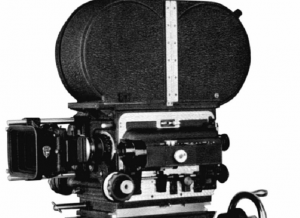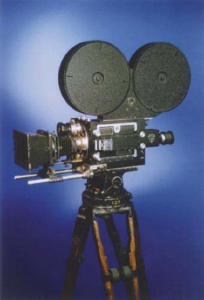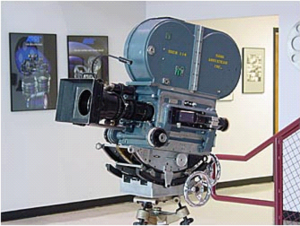Patrick Heigham
I worked on "Ninety Years On" as Gram Op. We had been doing lots of inserts to this main programme celebrating Churchill’s 90th. The time came to stitch it all together in a continuous run. (in Studio G – LG). Noel Coward in studio for live VO, lots of TK and VT inserts with narration and FX from Grams.
I accidentally ran through a spacing leader on the 1/4" tape with the fader open, thus playing the next bit of recorded narration.
Mills left his seat in the Production gallery – stormed into the Sound gallery and yelled at me: "That’s going all over the World, and you’ve made a mistake!"
Just after that, there was an early miscue for a VT insert, and the first few bars of the incoming music was a late fade.
Then a cut to a studio camera on a caption, caught it focussing up.
After that, it all came to a grinding halt, and all recording machines were halted (625, 525, 35mm and 16mm telerecording)
Of course, it was to my mistake that it all went back to!
I left the BBC TVC on the point of embryo Sound Supervisor. Moving into the film industry, I had to start again, as a lowly Sound Camera Operator. The net result was that
a) I learned how film worked, andb) was able to bring to a number of features, techniques derived from my trainingwith the BBC. (resulting in an Oscar for Sound – not me personally, but for my HOD).
Coming from TV, I was used (as a Boom Op) to having a monitor to see the shot.
On one of my first features. I ventured to peek through the viewfinder, to be turfed off by the camera operator: "I’m the one who looks through!" So, on asking for a top of frame limit, he winds up the tilt, says: "You’re OK there", and winds down again. Not good enough, and I told him so. Daggers at dawn for the rest of the movie. If an operator trusts the boom op = great!
Another story about camera operators – a lot of alibi-ing goes, or used to go on, if a take (and therefore wasted cost of film stock) is spoiled by inept operation. A shot required a fast pan round, and the operator tripped over the legs: "Sorry, guv, caught the boom – go again!" The Sound Mixer grinned, and said: "It’s all on Radio mics – no boom!"
Geoff Fletcher
I had a similar experience to that – it was only on a “Tales of the Unexpected” – minor stuff compared to what Pat Heigham was working on, but we did a lot of them. Lots of alibi-ing – including the rubbing of side of nose/tugging of left earlobe etc. by the camera operator to the clapper-loader when checking the gate after a dodgy take – resulting in a "Sorry Guv! Hair in the gate", followed by "OK, reset everybody and let’s go again!" Happy Days.
John Howell
I had thought that the phrase "it’s a wrap" referred to the putting of an exposed film into its light-proof bag ready to send off for processing. But it appears to be an acronym for “Wind, Reel And Print”, although what the act of ‘Reeling’ is I can’t quite fathom.
Alasdair Lawrance
It was a surprise to me, too, as I’d always thought it was "Wrap" as in ‘wrap it up’. But apparently it’s RAP, “rewind and print”.
Peter Hider
I believe that WRAP is wrap and it stands for ‘Wind Roll And Print’. It comes from the early days of filming in the States when the roll of film having gone through the camera had to be rewound through the camera onto the original spool before being sent for processing and printing.
The derivation of ‘Turn Over’, the command for starting the cameras and sound recording equipment before marking the shot with the clapperboard, comes from the days when the camera lens itself was used as a viewfinder to line up the shot and then the lens turret was turned over to put the lens back in front of the film gate and a crosswire frame was then used as a viewfinder during shooting. Through-the-lens viewfinders came in much later when mirrored shutter blades were developed. These reflect a separate image through an alternative set of lens elements to the cameraman’s eyepiece. This remains the case and is why when shooting film the image flickers in the viewfinder when the camera is running. It also means that you can’t take your eye off the eyepiece during shooting as light would travel back down this path and fog the film.
Maurice Fleisher
The Mitchell BNC (nothing to do with and long before video connectors) was a rack-over 35mm camera as described by Peter.
(Click on the picture below to see larger version:
use your Browser’s BACK button to return to this page)
After framing and focussing it was racked back again for shooting. The camera had a separate large optical ground-glass viewfinder attached to the side of the camera body. This was on the focus attachment geared such that the closer the focus was pulled the more the attachment swivelled to the right to compensate for parallax error….and vice versa of course.
The 35mm Mitchell Standard NC (News Camera would you believe) was unblimped. Fancy carrying even the NC on your shoulder for news anyone?
(Click on the picture below to see larger version:
use your Browser’s BACK button to return to this page)
After sound movies came in Mitchell produced an integral blimped version (BNC).
Then came the BNCR (reflex).
(Click on the picture below to see larger version:
use your Browser’s BACK button to return to this page)
Peter Neill
I believe that Wind Reel And Print is an example of what is known as a Backronym – that is, a phrase which has been manufactured to fit. Although IMDB gives that derivation, it is just about alone. Apparently "Wrap Parties" we’re a feature of the American theatre scene long before movies came along.
Patrick Heigham
I understood that WRAP came from the circus/vaudeville days. They would “Fit-Up” and “Wrap” the exhibition tent and scenery. The first movie film to be publicly “Projected” in the US took place in Piedmont Park in Atlanta in a tent in 1895 during the Cotton States Exposition (which was a Southern states version of the 1851 Crystal Palace Exhibition)
Early film cameras had no take up spool but dropped the film loose into a lightproof bag as it passed through the camera. Hence the term “It’s in the bag” origin. The film would then be rewound back onto the spool with the lens cap on. The spools were made of wood dowelling with tinplate flanges. Rewinding film was commonplace, my grandmother’s ¼ plate 1901 bellows Kodak stills camera required the film to be rewound, and of course 35mm stills cassettes required rewinding.
“Turn over” came from the same era where the winding handle of the camera stuck out of the back of the camera. The shaft was directly connected to the shutter.
I recall the term “rack-over” used when the viewfinder/camera was moved across the lens. It was also why the BNC blimp was so bulky. I don’t recall reflex viewfinders really coming in until the end of the 60s as the revolving mirror/shutter affected the exposure time. Movie negative was very slow 25ASA down to 16ASA with an obligatory 85 filter for daylight.
Modern movie negative film processes backwards into the bath. It comes out front out. The answer contact printer is run front to end and shipped end out. The first job of the cutting room was to rewind the picture before syncing up rushes. “Clever” clog assistants would sometimes sync up backwards!
When I was an “optical” sound camera operator we used to do xmod, density and clash tests at the end of the shot sound roll, unlace, take the magazine to the darkroom, pull out 20 ft or so off the end of the roll and then wind it into a Paterson developing tank, develop, fix and dry it and then examine the test through a “densitometer”!. NO modulometers in those days!. When it was okay we would ship the roll to the lab.
As to POSH, I too thought that it referred to those that could choose their cabins on a voyage to the Far East, would opt for Port side, outward, as the sun would be to the South (no air-conditioning, then), thus on the shaded side of the ship.
I experienced such a trip, when at 6 1/2, going with my mother to join my Army father in Singapore. I recall great scoops poked out of the portholes to try and get some breeze into the cabins.
In those days a journey from Liverpool to Singapore took around 5 weeks, but one became gradually acclimatised as the temperature rose.
Now, a 11-13 hour flight spits one out into a hugely different environment, with a bit of a surprise. Getting off the plane in Bangkok (for "Man With The Golden Gun" – OK, name dropping!) it felt as though someone had dropped a hot, wet blanket over me!
John Howell
This reminds me of a phrase: "Wound Forward", I used to see this on 1/4 Inch music tapes from commercial studios. We used the term "Tail Out" within the BBC.
If there was no statement it was assumed to be "Head out" and as a result this was a phrase that was not really needed.
Patrick Heigham
I remember boom operating on TW3.
During one sketch, my mic just dipped into shot, whereupon I got yelled at over talkback from the director (don’t recall it being Ned).
Ironic, because the next cut was a zoom-back from the catwalk camera showing the whole studio (kit and crew in vision!)
(see in a similar context: http://tech-ops.co.uk/next/2013/11/a-whole-mole-page-from-alec-bray/)





